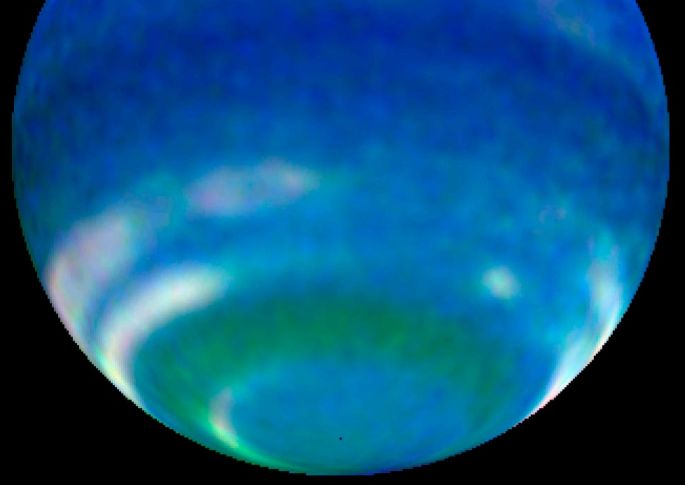Credit & Copyright: L. Sromovsky and P. Fry (Univ.
Wisconsin - Madison) et al.,
NASA
Explanation:
In the 1960s spring came to the southern hemisphere of
Neptune,
the Solar System's outermost gas giant planet.
Of course, since Neptune orbits the Sun once every 165
earth-years,
it's still spring for southern Neptune, where
each
season lasts over four decades.
Astronomers
have found that in recent years
Neptune has been
getting
brighter, as illustrated in
this Hubble Space Telescope image made in 2002.
Compared
to Hubble
pictures taken as early as 1996,
the 2002 image shows a dramatic increase in reflective
white cloud bands in Neptune's southern hemisphere.
Neptune's
equator is tilted 29 degrees from the plane of its orbit,
about the same as Earth's 23.5 degree tilt, and
Neptune's weather
seems to be dramatically responding to the
similar relative seasonal increase in sunlight -- even though
sunlight is 900 times
less intense for the distant gas giant than for planet Earth.
Meanwhile, summer is really just around the
corner, coming to
Neptune's southern hemisphere in 2005.
1999 2000 2001 2002 2003 2004 2005 2006 2007 2008 2009 2010 2011 2012 2013 2014 2015 2016 2017 2018 2019 2020 2021 2022 2023 2024 2025 |
Yanvar' Fevral' Mart Aprel' Mai Iyun' Iyul' Avgust Sentyabr' Oktyabr' Noyabr' Dekabr' |
NASA Web Site Statements, Warnings, and Disclaimers
NASA Official: Jay Norris. Specific rights apply.
A service of: LHEA at NASA / GSFC
& Michigan Tech. U.
|
Publikacii s klyuchevymi slovami:
Neptun - izmenenie klimata
Publikacii so slovami: Neptun - izmenenie klimata | |
Sm. takzhe:
Vse publikacii na tu zhe temu >> | |
